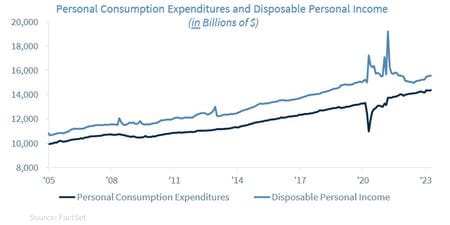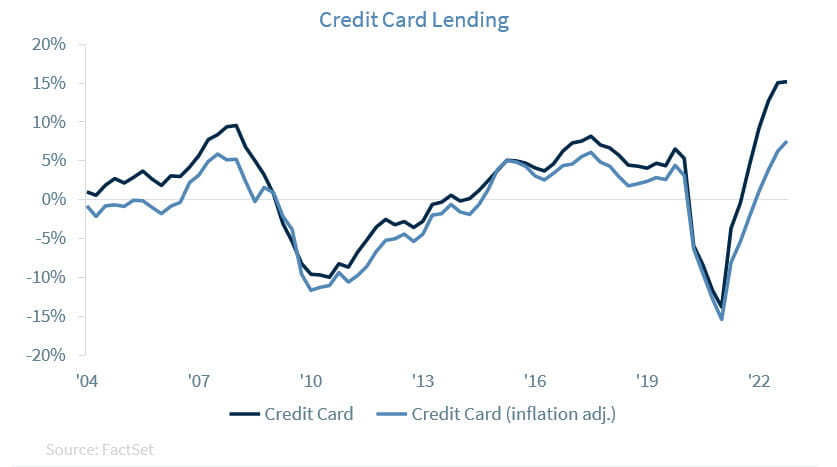by Eugenio J. Alemán, Chief Economist, Raymond James
As markets and investors are waiting to hear the good news of a potential resolution to the debt ceiling issue, the U.S. economy has continued to plow ahead. The economy has paid little attention to the stress in financial markets created by the recent failure of several regional banks, which seems to have tightened credit markets even further, and to the delayed negotiations regarding the debt ceiling, which continue to cloud the expectations for future economic growth.
So, let’s recap what happened during the COVID-19 pandemic, during which time the economy kept churning due to the large transfers of income from the Federal Government to individuals and firms. That is, during and in the aftermath of the COVID-19 pandemic, much of the growth in economic activity was due to the savings accumulated during the pandemic. Yes, employment was also coming back strongly after the first months of the COVID-19 pandemic, providing an income flow lifeline during that period to those employed as well as those getting hired again, but the excess or accumulated savings helped Americans battle the rise in prices (inflation) that ensued as the economy recovered. An economy with less than full employment but with robust financial conditions by businesses and individuals due to the fiscal policies put forward by the Trump and Biden administrations kept the ball rolling during 2021 as well as 2022 despite the strong increase in prices.
However, as excess savings continue to be depleted, inflation is slowing and employment has remained relatively strong, Americans are depending less on the savings accumulated during the pandemic and are starting to fund their purchases with the growth in real disposable personal incomes. That is, it is now the flow of ‘old-fashioned’ real disposable personal income that is driving economic activity rather than any help from the U.S. Federal Government, which should be good news for markets and for the sustainability of economic growth. However, we are still forecasting a mild recession starting in the third quarter of this year as we expect the increase in the federal funds rate to continue to put downward pressure on economic activity going forward
Inflation takes a bite out of real incomes in April
Although we had a good start to the second quarter of the year in terms of both income and expenditures, inflation in April continued to take some of this strength away, as real disposable personal income remained flat during the first month of the second quarter. However, Americans dipped into savings once again in April to support an increase in real personal consumption expenditures. But this cannot go on forever so inflation has to continue to go down if we expect the economy to continue to grow. Although PCE inflation was stronger than expected in April we should see lower inflation readings in May, which will help bring down inflation again on a year-earlier basis.
This is the reason why the state of the labor market, and employment, as well as the path of future inflation, will remain so important for the U.S. economy and for the prospects for future growth. Weakness in employment and higher inflation will do away with the current income lifeline, and then the economy will probably go into recession. Thus, anything related to the state of the U.S. labor market and inflation will continue to drive economic headlines.
Furthermore, and as we have said in the past, if the labor market weakens considerably, we are concerned with those that have complemented their incomes/excess savings with higher credit card borrowing over the last year or so. Credit card borrowing, which is the sector of the borrowing market that commands the highest interest rate of all the credit sectors, could be the catalyst that helps bring consumption down if Americans start losing their jobs. Furthermore, for financial firms engaged in credit card lending, a weakening of the labor market will also have consequences, as credit card lending is uncollateralized, and firms will have trouble collecting on those debts.
Thus, Fed officials will pay very close attention to the incoming inflation number for May to see if they change their expectations about what to do with the federal funds rate. Today, markets have priced a further 25 basis point increase in the rate, to 5.50%. However, we still believe that the Fed will refrain from increasing the federal funds rate in June because we expect better inflation readings in May. Having said this, at this moment, it is hard to know what Fed officials are going to do. For now, we are sticking with our pause call for June.
Economic and market conditions are subject to change.
Opinions are those of Investment Strategy and not necessarily those of Raymond James and are subject to change without notice. The information has been obtained from sources considered to be reliable, but we do not guarantee that the foregoing material is accurate or complete. There is no assurance any of the trends mentioned will continue or forecasts will occur. Last performance may not be indicative of future results.
Consumer Price Index is a measure of inflation compiled by the US Bureau of Labor Statistics. Currencies investing is generally considered speculative because of the significant potential for investment loss. Their markets are likely to be volatile and there may be sharp price fluctuations even during periods when prices overall are rising.
Consumer Sentiment is a consumer confidence index published monthly by the University of Michigan. The index is normalized to have a value of 100 in the first quarter of 1966. Each month at least 500 telephone interviews are conducted of a contiguous United States sample.
Personal Consumption Expenditures Price Index (PCE): The PCE is a measure of the prices that people living in the United States, or those buying on their behalf, pay for goods and services. The change in the PCE price index is known for capturing inflation (or deflation) across a wide range of consumer expenses and reflecting changes in consumer behavior.
The Consumer Confidence Index (CCI) is a survey, administered by The Conference Board, that measures how optimistic or pessimistic consumers are regarding their expected financial situation. A value above 100 signals a boost in the consumers’ confidence towards the future economic situation, as a consequence of which they are less prone to save, and more inclined to consume. The opposite applies to values under 100.
Certified Financial Planner Board of Standards Inc. owns the certification marks CFP®, CERTIFIED FINANCIAL PLANNER™, CFP® (with plaque design) and CFP® (with flame design) in the U.S., which it awards to individuals who successfully complete CFP Board's initial and ongoing certification requirements.
Links are being provided for information purposes only. Raymond James is not affiliated with and does not endorse, authorize or sponsor any of the listed websites or their respective sponsors. Raymond James is not responsible for the content of any website or the collection or use of information regarding any website's users and/or members.
GDP Price Index: A measure of inflation in the prices of goods and services produced in the United States. The gross domestic product price index includes the prices of U.S. goods and services exported to other countries. The prices that Americans pay for imports aren't part of this index.
The Conference Board Leading Economic Index: Intended to forecast future economic activity, it is calculated from the values of ten key variables.
The Conference Board Coincident Economic Index: An index published by the Conference Board that provides a broad-based measurement of current economic conditions.
The Conference Board lagging Economic Index: an index published monthly by the Conference Board, used to confirm and assess the direction of the economy's movements over recent months.
The U.S. Dollar Index is an index of the value of the United States dollar relative to a basket of foreign currencies, often referred to as a basket of U.S. trade partners' currencies. The Index goes up when the U.S. dollar gains "strength" when compared to other currencies.
The FHFA House Price Index (FHFA HPI®) is a comprehensive collection of public, freely available house price indexes that measure changes in single-family home values based on data from all 50 states and over 400 American cities that extend back to the mid-1970s.
Import Price Index: The import price index measure price changes in goods or services purchased from abroad by U.S. residents (imports) and sold to foreign buyers (exports). The indexes are updated once a month by the Bureau of Labor Statistics (BLS) International Price Program (IPP).
ISM New Orders Index: ISM New Order Index shows the number of new orders from customers of manufacturing firms reported by survey respondents compared to the previous month. ISM Employment Index: The ISM Manufacturing Employment Index is a component of the Manufacturing Purchasing Managers Index and reflects employment changes from industrial companies.
ISM Inventories Index: The ISM manufacturing index is a composite index that gives equal weighting to new orders, production, employment, supplier deliveries, and inventories.
ISM Production Index: The ISM manufacturing index or PMI measures the change in production levels across the U.S. economy from month to month.
ISM Services PMI Index: The Institute of Supply Management (ISM) Non-Manufacturing Purchasing Managers' Index (PMI) (also known as the ISM Services PMI) report on Business, a composite index is calculated as an indicator of the overall economic condition for the non-manufacturing sector.
Consumer Price Index (CPI) A consumer price index is a price index, the price of a weighted average market basket of consumer goods and services purchased by households. Changes in measured CPI track changes in prices over time.
Producer Price Index: A producer price index (PPI) is a price index that measures the average changes in prices received by domestic producers for their output.
Industrial production: Industrial production is a measure of output of the industrial sector of the economy. The industrial sector includes manufacturing, mining, and utilities. Although these sectors contribute only a small portion of gross domestic product, they are highly sensitive to interest rates and consumer demand.
The NAHB/Wells Fargo Housing Opportunity Index (HOI) for a given area is defined as the share of homes sold in that area that would have been affordable to a family earning the local median income, based on standard mortgage underwriting criteria.
The S&P CoreLogic Case-Shiller U.S. National Home Price NSA Index measures the change in the value of the U.S. residential housing market by tracking the purchase prices of single-family homes.
The S&P CoreLogic Case-Shiller 20-City Composite Home Price NSA Index seeks to measures the value of residential real estate in 20 major U.S. metropolitan.
Source: FactSet, data as of 5/26/2023
















